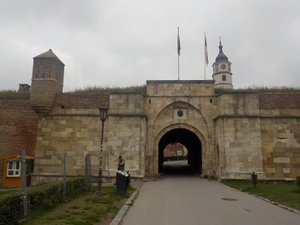Advertisement
Published: July 24th 2018

 DSCN1089
DSCN1089
The fortressWe woke up early again so that we could eat and join the tour for the day. Today’s tour was the Best of Belgrade. The ship is docked on the Sava River. The Sava joins the Danube in Belgrade which is why this area is so important and has be fought over for so many years. Cargo ships dock on the Danube while passenger ships dock on the Sava. The two rivers were both major water highways, plus there were several overland pathways connecting east and west; Belgrade was where all the action was.
Last night we learned a little history of Belgrade and it turns out there have been 115 wars in the area over the last couple of thousand years. The city has been destroyed 44 times and rebuilt 45. In one 3-year period, the city changed hands 5 times. Our first stop on the outing was the fortress at the top of the hill (Kalemegdan). This hill is situated between the Danube and Sava rivers and has water on 3 sides. It was the most strategic fort in the area and had multiple lines of defenses. In earlier times, this side of the river was part of

 DSCN1096
DSCN1096
Ruins at the fortressthe Ottoman Empire and across the river was the Austrian Hungarian Empire. There were many conflicts during this time period. We learned that the first shots of World War I occurred here, when the Austrian Hungarian Empire shot at the fork which was then part of Serbia. Serbia was on the Allied side of the conflict but did get occupied when the Croatian and Slovenian Serbs decided to fight for the Austrian Hungarian Empire. We also learned that the fort dates to the Roman times but of course was built upon and expanded many times after that.
The fortress is in old Belgrade. New Belgrade was started after WWII. They took the silt and dirt form the rivers and filled in the land, it was a swamp. They built upon this filled in land. Since Yugoslavia was under Soviet control, many buildings in new Belgrade were built in the bland Soviet style. The housing flats were very typical of what we associate with Soviet architecture. Recently though, new Belgrade is becoming popular with the younger generation.
After traversing new Belgrade some, we toured more of the old city. We went to the St Sava Church which is still

 DSCN1098
DSCN1098
Danube and Sava Riversbeing built. It is the largest orthodox church in Europe. We could only go into the crypt area but if the rest of the church is going to look the same, it is beautiful. There is a Moorish style of arches inside, but the light and golden color just made it lovely
We learned a few facts about Serbia.
· Most Serbian names end in “ic”.
· 95% of worlds raspberries come from Serbia.
· The only Serbian word known throughout the world is vampire.
· The Serbian clock industry is 600 years older than the Swiss
Serbia was at war with Croatia and Bosnia in the early 90s and then with Kosovo in the late 90’s. During the Kosovo war, NATO bombed Belgrade and you can still see some of the damage today. We then were dropped off at the shopping district for a bit and then took the bus back to the ship.
After lunch we took the shuttle back to town and Susan found 3 lovely pair of handmade earrings that she bought. She converted $20 to the Serbian Dinar and got all 3 pair for around $17. The rest

 DSCN1102
DSCN1102
Statue of WWI where 60% of the male population was lostof the money will go to Stephanie who loves to collect local currencies.
We came back to the ship to listen to a lecture on the history of Serbia. Yes, we got the information from the viewpoint of a Serbian but given all he explained to us and the history, you can understand some of the wars. I still find that the most interesting part is how much people seem to have really loved Yugoslavia when all the different ethnic groups lived together and prospered. Yugo means Southern and Slavia stands for the Slavics. That is how the name of the country came into being. The speaker of course also mentioned the “Yugo” car. How many of y’all remember it?
After the presentation, we went to dinner. We choose the “taste of the Balkans” sampler and enjoyed the variety. A mother daughter pair joined us, and we enjoyed talking with them. The mother is a vascular surgeon and her daughter recently married and moved to California where her husband found a position teaching. She used to work for congress and is looking for work. After dinner we took a kitchen tour and then went to the lounge to

 DSCN1108
DSCN1108
St Sava Churchsee the local dance and music show. The local dance reminded me a lot of the Russian style of dance along with the gypsy style of dance. The clarinetist in the local band was amazing; the whole show was wonderful. Tonight, we lost an hour and had to move our clocks ahead.
Advertisement
Tot: 0.435s; Tpl: 0.02s; cc: 9; qc: 55; dbt: 0.0893s; 1; m:domysql w:travelblog (10.17.0.13); sld: 1;
; mem: 1.2mb



















































 DSCN1089
DSCN1089
 DSCN1096
DSCN1096
 DSCN1098
DSCN1098
 DSCN1102
DSCN1102
 DSCN1108
DSCN1108
















